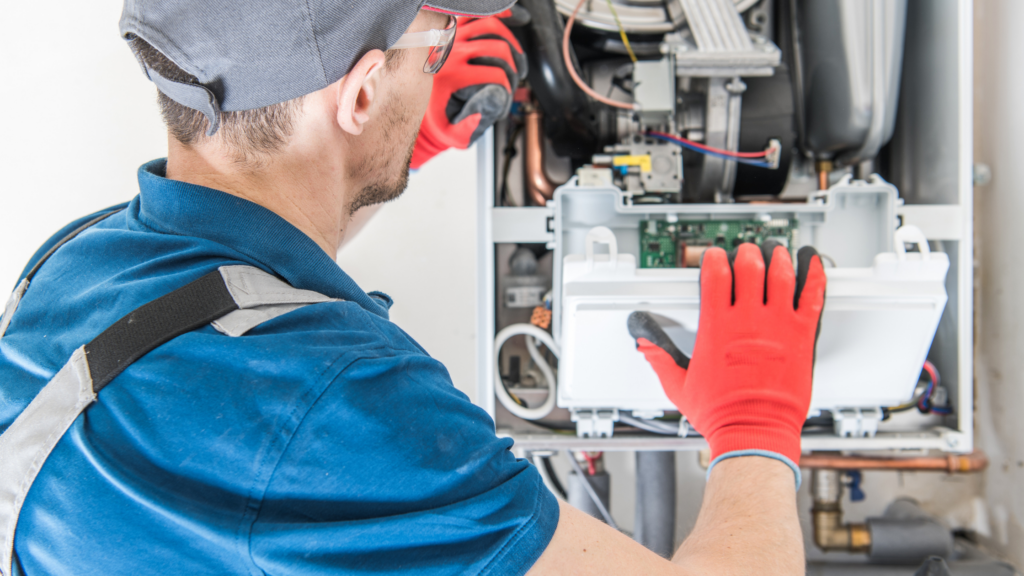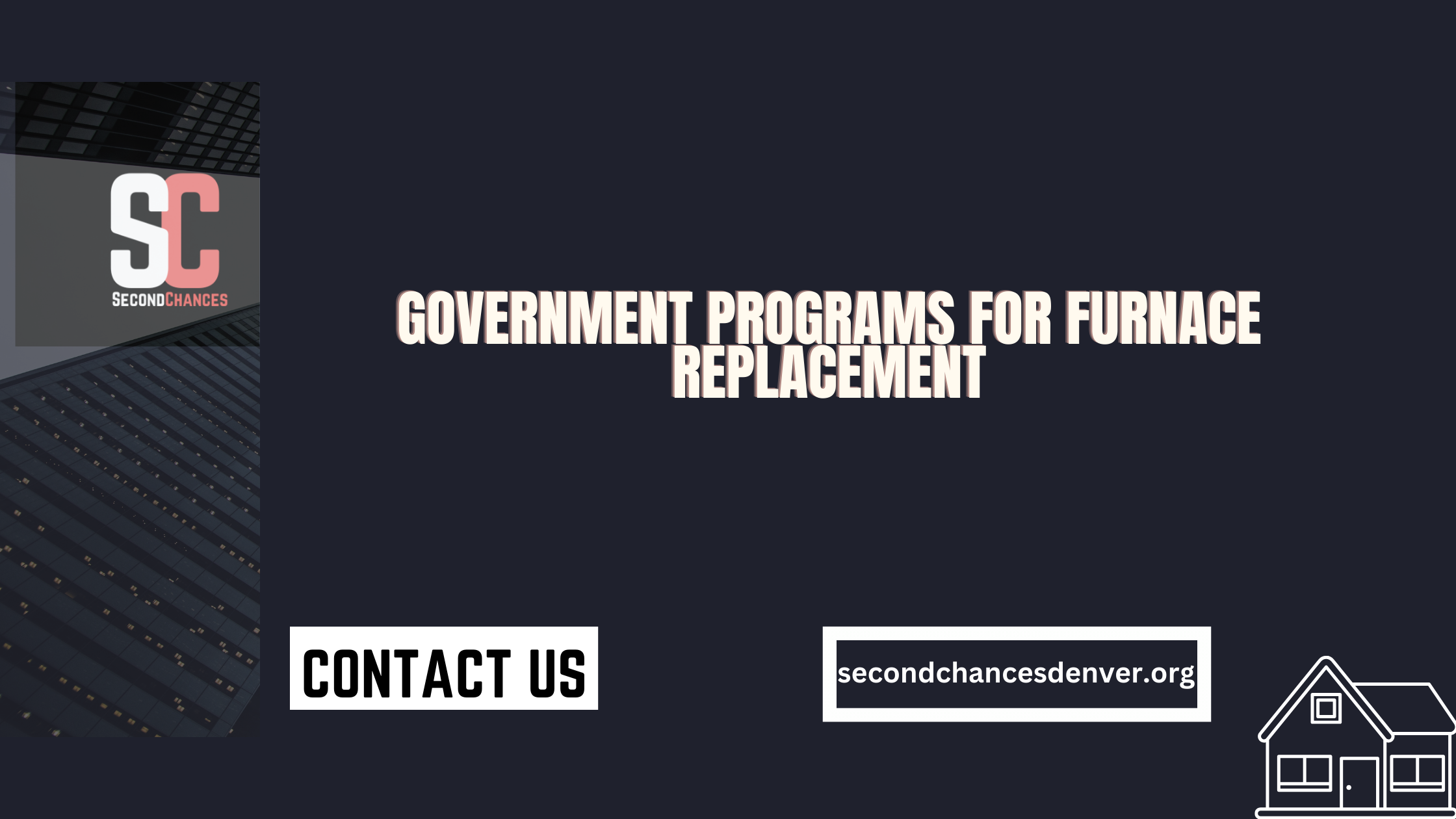Are there any Government Programs For Furnace Replacement? Yes, there are Government Programs For Furnace Replacement, and we will let you know some more effective and reliable programs in this article.
Furnaces or boilers heat the majority of American homes. Using ducts, furnaces distribute heated air throughout the house. A boiler is a device that heats water and provides hot water or steam for heating. In steam radiators, steam is distributed via pipes, hot water is distributed via radiators or radiant floors, and air is heated through coils.
All boilers and furnaces are currently available in high-efficiency versions despite steam boilers operating at higher temperatures. Our Energy Saver 101 infographic explains the basics of furnaces, boilers, and other home heating systems.
Table of Contents
What is a Furnace?

Generally, furnaces provide direct heat for industrial processes that require temperatures higher than 752°F (400°C). It is necessary to heat many industrial processes so that materials can be prepared for production or applications can be completed. Electric and fired industrial furnaces’ temperature control and reliability are always reliable and dependable.
Electrical and fired industrial furnaces are the two general types. Induction or arc furnaces are electrical industrial furnaces. Induction is used for melting metals, while arcs are used for refining. Burning fuel to heat raw materials or sinter finished parts is the primary heating method in fired furnaces.
What is the Furnace used for?
Using ducts, furnaces distribute heated air throughout the house. In a boiler, water is heated, and steam is provided for heating. A steam radiator circulates steam via pipes, and a coil distributes hot water or heats air via a radiator, radiant floor, or baseboard.
Government Programs for Furnace Replacement for Free
Low-income families won’t receive grants directly from the federal government in 2023. They are eligible for Government Programs For Furnace Replacement, and the money goes to state agencies to provide families with heating, ventilation, and air conditioning (HVAC) assistance.
If you know where to look and factor in the total cost of ownership, these federal programs may result in free replacements of furnaces, water heaters, and air conditioning units. Read about how each government grant program could translate into a free furnace or air conditioner.
Consumers can get grant money to buy, install, and operate HVAC replacement systems across their lifecycles (purchase, installation, and operation). Keeping the environment clean is a top priority for the federal government, which unlocks significant benefits to reduce costs.
Note – If you are a cancer patient then cancer treatment can be a long and expensive journey for you, and the cost of housing can be a major burden for patients and their families. However, such as Government Programs For Furnace Replacement there are several free housing programs are available to cancer patients who meet certain eligibility requirements.
Eligibility For Government Programs for Furnace Replacement and Grants
Grant programs may offer funding for HVAC replacement projects if you need assistance replacing your HVAC system. Government agencies and nonprofit organizations offering Government Programs For Furnace Replacement will have a set of eligibility criteria.
- Types of grants will generally have different eligibility requirements.
- There are several common requirements, including:
- Some grants require proof of income and assets to demonstrate a genuine need for financial assistance.
- A grant may be available only to applicants of a certain age group, such as seniors, or from a certain geographic area.
- The applicant must reside in the area where the grant is being applied to qualify for some grants.
- You must prove that you own or occupy your home to qualify for certain grants.
- Grants may be granted according to the type of Furnace, such as electric or gas.
- The Furnace must be in a certain condition to qualify for some grants.
Grant programs may also have specific criteria for receiving funding that must be met. A thorough review of all criteria should be conducted before applying. As a result, you can determine whether your application is eligible for a particular grant program.
Application Process For HVAC Replacement Grants Under Government Programs For Furnace Replacement
You may be eligible for a grant if you need to replace your HVAC system. Researching and finding out what grants are available in your area and their specific requirements is the first step toward applying for an HVAC replacement grant.
You will need to submit a grant application with all the necessary information once you have identified the grant you wish to apply for:
• Your contact information
• Proof of residence
• Proof of income
• The type and size of Furnace you need
• A description of how the Furnace will be used
• Any additional information requested by the grantor
Additionally, if the property isn’t in your name, you may need to provide a deed or proof of ownership. Evidence of need may also be required. Generally, you must prove you cannot afford to replace your Furnace to qualify for a grant.
Completing the application process may take some time, so allow yourself enough time. You may be required to provide additional information or documentation after reviewing and approving your application.
You can begin replacing your HVAC system once all the paperwork has been filed and your grant money has been disbursed. To qualify for a grant, you must comply with strict eligibility requirements, and other terms and conditions may also exist. Before submitting your application, make sure you review all requirements carefully.
Free Government Programs For Furnace Replacement
You may be surprised to learn that free government grants are available to help homeowners replace their old, inefficient furnaces.
As a result of these grants, homeowners can transition to more eco-friendly heating systems and become more energy efficient. This program can help you save money while reducing your carbon footprint and creating a more comfortable living environment.
Weatherization Assistance Program (WAP) Under Government Programs For Furnace Replacement
US government grants, including the Weatherization Assistance Program (WAP), help low-income families improve their energy efficiency.
As part of the WAP, funds are provided for weatherization improvements and professional services, including furnace repair or replacement. The program prioritizes families with at least one member with a disability. Households participating in WAP can reduce their energy consumption, utility bills, and quality of life.
Financing Under Government Programs For Furnace Replacement
It is possible for consumers to self-create non-government grants by focusing on the total cost of ownership of energy-efficient HVAC systems. Investing in upgraded equipment could save more than the investment in electricity and gas.
Families can save on energy by matching the monthly savings to the equipment investment with no credit check HVAC financing. You can upgrade your system for free as follows:
- Purchase and install the equipment with borrowed money
- Gas and electric bills can be reduced each month by saving money
- Energy savings might outweigh the monthly payments
LIHEAP
A government grant that assists low-income households with their HVAC needs is the Low-Income Home Energy Assistance Program (LIHEAP). Much of LIHEAP’s budget is allocated to lower utility bills (gas and electricity).
You can apply for LIHEAP through your state agency for new or existing furnaces or air conditioners. It is important to remember that operating expenses represent a significant portion of the total cost.
Receiving help to pay for energy can make it easier for you to afford a new furnace or air conditioner!
The Inflation Reduction Act (IRA)
A new government grant program specifically targeting HVAC conversion systems is being introduced with the Inflation Reduction Act (IRA). Cleaner energy equipment can be purchased through this innovative initiative by taking advantage of rebates and tax credits.
As much as $14,000 rebates are available to homeowners under the IRA. A portion of these funds can be used to purchase, install, and upgrade equipment that promotes cleaner electricity over dirtier natural gas.
The Home Energy Assistance Program (HEAP)
It provides low-income households with financial assistance for home energy costs, including furnace replacement, through the Home Energy Assistance Program (HEAP).
Heating and cooling expenses are made affordable for eligible households by the HEAP program, which emphasizes the needs of vulnerable populations. Energy-related home repairs, including furnace replacement, are partly covered by grants for approved applicants.
Low-income households benefit greatly from HEAP, which ensures comfort, reduces energy costs, and promotes energy efficiency.
HE+ Furnace Program Under Government Programs For Furnace Replacement
Under the HE+ Furnace Program, low-income households in Wisconsin are assisted when their primary heating system is out of service, inoperable, or unsafe. When completing the referral to the Weatherization Agency, the Wisconsin Home Energy Assistance Program (WHEAP) Agency verifies applicant eligibility and reserves funds. Providing timely service is a priority for WHEAP and weatherization agencies.
Central Heating Improvement Program (CHIP)
Low-income households can receive heating system repair and replacement services through MaineHousing’s Central Heating Improvement Program. No-heat households receive priority. As with the Home Energy Assistance Program (HEAP), CHIP is administered by local community action agencies. Households may have to make a co-payment towards the overall cost.
Heating Repair Replacement Program
Low-income households can receive a government grant to repair or replace their heating systems as part of the Heating Repair Replace Program.
It aims to ensure that homes are heated safely and efficiently, especially for people who are struggling financially. Families with low and moderate incomes can benefit from this program by replacing their primary heating systems.
As well as HRPP, the federal Weatherization program often assists participants. Heating unit repair services include water heater wraps, leak fixes, thermostat regulation, and energy conservation education.
Additionally, users can receive assistance in repairing or replacing their primary heating systems. You should contact the relevant government agency or organization to learn more about how to access this grant.
State’s Public Utility Commission
Rural residents in designated rural areas can receive government grants to replace their furnaces through the United States Department of Agriculture (USDA).
Its goal is to reduce energy costs and improve energy efficiency in low-income households. Those eligible for funding can replace their old furnaces with more energy-efficient models, increasing their comfort and saving them money. Rural communities benefit from USDA grants by supporting sustainability efforts.
Rural Energy For America Program (REAP)
United States Department of Agriculture (USDA) administers the Rural Energy for America Program (REAP). It offers financial assistance to rural communities to replace their furnaces and improve their energy efficiency during its application process.
Through REAP, rural communities are encouraged to adopt renewable energy, improve energy efficiency, and develop their economies. The program prioritizes projects that contribute to energy savings and benefit the local community.
Providing financial assistance and other government programs for furnace replacement and other energy efficiency initiatives is important to REAP’s role in encouraging sustainability and promoting rural development.
Types of Furnaces for Heating Homes and Buildings
Through ducts, furnaces deliver heated air to different rooms in homes and other buildings. Burning fuel, using electricity, or other methods can provide heat energy for a furnace. Furnace cost, fuel cost, venting requirements, and Annual Fuel Utilization Efficiency (AFUE) are all factors to consider when determining how efficient a furnace is.
The following types of furnaces will be described in the first part of this article:
- Gas-fired
- Oil fired
- Waste oil
- Duel fuel
- Electric
- Wood burning
- Gas-Fired Furnaces
The most common heating fuel in American homes is gas, used in 57 percent of homes. In addition to the cost of the gas furnace, it may be necessary to install a municipal gas line. The AFUE rating of new gas furnaces is 89 to 98 percent.
In terms of non-renewable energy options, gas is the cleanest burning. There is a risk of carbon monoxide leaks with gas furnaces, which makes carbon monoxide detectors necessary. The life expectancy of a gas furnace is up to 25 years, and they tend to be easier to maintain than oil furnaces since they remain clean even when used constantly.
Oil-Fired Furnaces
In areas with limited access to natural gas, oil-fired furnaces are popular because they have high AFUE ratings. A gas furnace has a lifespan of 50 years, while an oil furnace has a lifespan of 30 years, but oil is more expensive (often imported), and the price can fluctuate. To operate an oil furnace, a storage tank must be installed on-site. For oil-fired furnaces to remain efficient, the heat exchanger surfaces must be cleaned of soot and carbon deposits periodically. Additionally, the oil filters used to remove impurities from the fuel before the oil is vaporized and ignited may need to be replaced, as well as the nozzle on the burner unit.
Waste Oil Furnaces
Oil that is no longer suitable as a fuel, such as automotive or vegetable oil, is burned in waste oil furnaces. Because the oil is recycled, they are often marketed as green or environmentally friendly solutions.
When heated waste oil, contaminants such as lead, PCBs, and chromium can become airborne. Some areas require users to purchase permits and monitor chimney emissions to burn certain fuels. The EPA regulates which fuels are safe to burn. A regularly cleaned waste oil furnace can last up to 25 years and work more efficiently.
Dual Fuel Furnaces
For cool weather, dual-fuel furnaces use heat pumps; for cold weather, they use gas furnaces as this is the best Government Programs For Furnace Replacement. The purpose of a heat pump is to transfer heat from the outside to the indoors. As air passes over the coil of hot refrigerant inside the heat pump, it is heated and blown into the house by a fan.
The problem with heat pumps is that they could be more efficient during the colder months of the year. When the weather cools off, a dual fuel system switches from a heat pump to a gas heater. Though installing or upgrading a system can be costly, this is one of the most energy-efficient systems available on the market.
Electric Furnaces
Despite their high running costs, electric furnaces have advantages over gas and oil furnaces. The United States generally has access to electricity, even in areas where gas or oil are difficult to find or to deliver. With solar panels attached, electric furnaces can produce renewable energy and save money.
An all-electric furnace can recoup higher running costs through a higher AFUE of 95 to 100 percent. Since gas leaks and actual fires cannot occur in electric furnaces, they are considered safer than gas and oil options.
Wood-Burning Furnaces
Wood-burning furnaces are an excellent choice for heating homes and is one of the best Government Programs For Furnace Replacement in areas where firewood is plentiful and affordable. In the same way, oil and gas furnaces circulate heat through ductwork; wood is burned in a firebox. It is only practical if you plan to be away for an extended period if you fuel a wood-burning furnace manually and tending the fire. Burning oil or gas as a backup heat source makes wood furnaces part of a combination furnace.
State-of-the-art models can achieve AFUEs of 75 to 90%, whereas conventional wood furnaces may have an AFUE of 45 to 55 percent.
Frequently Asked Questions Regarding Government Programs for Furnace Replacement
What is the Heating System Repair & Replacement Program (HEARTWAP)?
Low-income households can receive heating system repair and replacement services through Massachusetts’ HEARTWAP program.
What is the Central Heating Improvement Program (CHIP)?
Low-income households can get heating system repair and replacement services through MaineHousing’s CHIP program. No-heat households receive priority.


